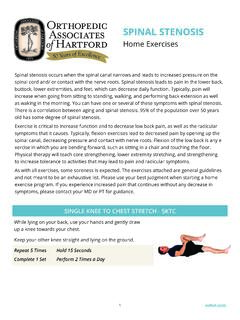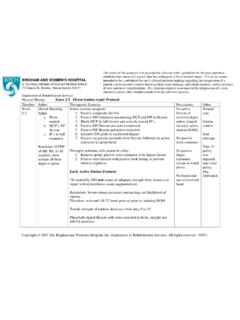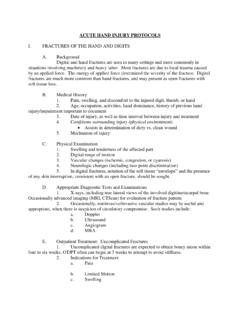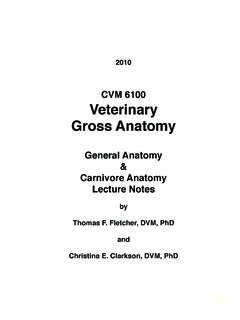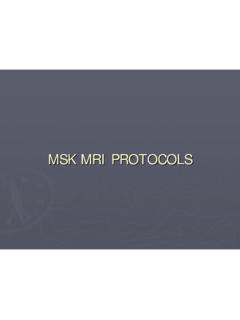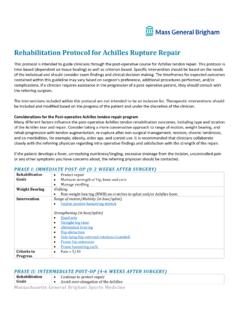Transcription of Achilles Tendon Rupture Repair Return to Sport Protocol
1 Achilles Tendon Rupture Repair Return to Sport Protocol Keys for Achilles Tendon Rehabilitation: - Calf girth, Plantar flexor strength and ankle ROM are all keys to full recovery. The ideal is to achieve full symmetry in all 3 areas. - ROM should be measure in both Open and Closed-Chain methods - Strength can be measured through use of the Single Heel Rise test and MMT should be scored using the criteria below: Testing Plantar Flexion in Standing: Grading: - 5/5 (N)= Patient successfully raises heel from floor through entire ROM of plantar flexion. Patient should complete a minimum of 20 repetitions in good form and without apparent fatigue. (tibialis posterior and the peroneus (fibularis) longus and brevis muscles must be between a 4/5 and 5/5 to stabilize the forefoot and provide counter pressure against the floor). *20 heel rises represents over 60% of maximum electromyographic activity of the plantar flexors - 4/5 (G)= Patient can complete 10-19 repetitions of heel rises with full ROM and then has difficulty completing the movement.
2 - 3/5 (F)= Full ROM for 1-9 repetitions of heel rises, and becomes fatigued. - 2+/5 (P)= Patient can just clear the heel from the floor and cannot get up on the toes for full ROM. - No grade for 2/5 in the standing position, all others tested in prone position with feet off the edge of the table. - 2+/5 (P+)= patient is able to plantar flex through available ROM against maximal resistance. - 2/5 (P)= Patient is able to complete plantar flexion full ROM however cannot tolerate resistance. - 2-/5 (P-)= Patient is able to complete only partial ROM. - 1/5 (T)= Their Tendon reflects some contractile activity in the muscle, however, no joint motion occurs. Contractile activity may be palpated in the muscle bellies. (The Gastrocnemius at mid-calf with thumb and finger on either side of the midline, above the soleus. Soleus is best palpated distally on the posterolateral surface). - 0/5 (ZERO)= no contractile activity * If the patient is unable to lie prone, alternate test position is supine, clinician cupping the heel, with their forearm against the plantar surface of the patient s foot, and a force applied into Dorsiflexion, after full ROM was assessed.
3 *Taken from Daniels and Worthington (2002) Muscle Testing: Techniques of Manual Examination, 5th edition. (860) 549-8210 Postoperative Achilles Tendon Rupture Repair Return to Sport Protocol Immediately Post-Op- Protection Phase (0-4 weeks Post-Op) Goals: Protect healing tissue Decrease/eliminate inflammation and edema, while controlling pain Prevent muscle atrophy and wound infection (to minimize scar formation) Patient Education: Posterior Splint or Boot must be worn day and night. Incision must be kept clean and dry. Non-Weight-Bearing for 3 weeks post-op, ambulation with bilateral crutches Cold Packs /Cryocuff should be used multiple times through the day with the leg elevated for first 1-2 weeks, then PRN Treatments: Splint/Brace: - Posterior splint in 10 -20 plantar flexion 24 hours/day for first 3 weeks, Progressing to boot at ~week 3 post-op (to be wore awake and while sleeping) with heel wedge to keep at ~10 plantar flexion. Weight-Bearing: - Non-Weight-Bearing for first 3 weeks Post-op, then patient may begin partial Weight-Bearing with Bilateral crutch in the boot with heel lift, (depending on MD Assessment).
4 Modalities: - Cold Packs post treatment to control pain, swelling, and inflammation - Moist Hot Packs are not to be utilized until 2 weeks post-op Gait Training: - Gait and stair training with crutches, for proper technique Manual Therapies & ROM: - PROM: Clinician administered PROM is not to be performed for 8 Weeks post-op, Patient should perform Gravity-Assisted PROM into plantar flexion in a seated position (once incision is healed). - AROM: ~3 weeks post-op patient may begin AROM exercises of the ankle, DF to neutral only with bent knee position, no active PF Proximal LE and Upper Body Kinetic Chain Strengthening Exercises: - No Ankle Strengthening for 1st 2 weeks, Sub-max. after 2 weeks no PF - 4-Way Hip SLR (Flex, Ext, Abd, Add), H/S curls - Foot Intrinsic Strengthening: Towel crutches, marbles, toe extension, etc. - Any UE and Core exercises in a LE non-weight-bearing position - Stationary Bicycle in the Boot Intermediate Protection Phase: (4-8 Weeks) Goals: Continue to protect the healing Achilles Repair Continue to decrease/eliminate pain and inflammation Continue to control/prevent muscular atrophy Progress to full weight-bearing Regain ankle range of motion (0 /neutral DF) (860) 549-8210 Patient Education: Educate patient on necessity to continue to wear the walking boot and adhere to restrictions to continue to protect the Achilles Repair while early motion and weight-bearing is initiate/progressed.
5 Brace must be worn whenever patient is in weight-bearing, it may be removed for shower/bath and to perform exercises. Treatments: Weight-Bearing: - Progress WBAT with Boot and 1-inch heel lift for 2 weeks, and then decrease to inch heel lift, D/C crutches when full weight-bearing in boot is achieved. Modalities: - Continue all modalities PRN for pain, inflammation, and swelling Gait Training: - Gait Training progression from PWB/WBAT FWB as tolerated. Manual Therapies: - Gentle scar mobilization to Achilles - PROM may be initiated at 8 weeks post-op, gentle into DF initially Exercises: - Continue foot strengthening, SLR exercises, leg press (no PF movement) - Seated Baps Board, Ankle gentle AROM- (alphabets, rotations, pumping) - End-range Isometrics, supine/ seated calf raises (low/no resist) - Weight Shifting: Towel roll under heels @ 4 weeks (no boot) Bilateral stance with boot, progress to stagger stance week 5 - Continue Stationary Bicycle with boot - Continue Upper Body& Core exer.
6 (seated/lying/CKC w/boot/LE on ball) Criteria for progression to Initial Strengthening phase: Full Weight-Bearing with Boot out of home, No Boot in home and clinic No Increased symptoms with current AROM & PROM exercises 0 -5 Dorsiflexion/ Neutral ankle ROM achieved- to be able to D/C boot Swelling/Edema controlled Initial Strengthening Phase (~8-12 Weeks) Goals: Increase ROM to 10 Dorsiflexion, Achieve full ankle ROM INV, EV, PF Continue to progress weight bearing tolerance, D/C Walking Boot all surfaces (~10 weeks) Normalized Gait Restore normal joint arthrokinematics of all foot and ankle joints Continue to protect healing tissues Decrease calf atrophy Patient Education: Education on progressing weight-bearing slowly, based on ROM and tolerance. Patient should continue to wear the boot, brace and/or heel lift until MD D/C s (860) 549-8210 Treatments: Weight Bearing: - Continue to progress weight bearing to FWB ing out of boot (with 1/4-1/2 inch heel lift in shoe/sneaker)~ 10 weeks post-op Gait Training: (MD may prescribe an ankle brace once boot is D/C d).
7 - ~10 Weeks taper out of boot in the home and clinic, continue to wear out of the home. ~12 weeks D/C boot if appropriate (MD will D/C boot). Manual Therapies: - Manual Mobilization of foot & Midfoot, gentle Subtalar & Talo-Crural mobilization- to help restore foot and ankle ROM - PROM all planes to improve foot and ankle mobility Exercises: - Light resistance band 4- way ankle exercise- gradually increase resistance - Seated (light resist), Standing (PWB) BAPS & decline boards- all planes - Forward, Retro and Lateral step up & downs- low step height - Progress DL heel raises supine, seated & add standing as tol. (~12 weeks) - Continue LE, Foot intrinsic, Hip, Core, & UE exercises, & Leg Press - Continue LE bicycle, can begin Retro Treadmill walking End of Phase Testing: Core Testing: (See attached sheets for description): 1-Segmental Multifidus Test, 2-Trunk Curl Up Test, 3-Double-Leg Lowering Test, 4-Side Bridge Test, 5-Prone Bridge Test, 6-Supine Single-Leg Bridge Test, 7-Extensor Endurance Test Criteria for progression to Advanced Strengthening phase: 10 Ankle Dorsiflexion, all other planes in normal ROM No pain, inflammation or swelling Normal Gait No increased symptoms with any of the current exercises Advanced Strengthening Phase (~12-22 Weeks) Goals.
8 Progress to full ankle ROM in all planes Increase strength and balance to be able to begin advanced activity skills No calf/muscle atrophy D/C brace if still being used (by MD only) Get Achilles Tendon Total Rupture Score (ATRS)- Self -Reported Patient Evaluation Good proprioception/balance in single-leg stance Gradually introduce sub-maximal agility & reaction drills (~18-20 weeks post-op), and Sport -like activities (20-22 weeks post-op) Get baseline FMS Assessment Screen & Y-Balance Test (~12-14 weeks) Initiate Walk-to Run (~16-18 weeks post-op), LE Plyometric Protocols (~18-20 weeks post-op) (860) 549-8210 Treatments: Continue to progress Dorsiflexion to normal ROM Continue to increase repetitions and resistance: As tolerated - 4-way ankle resistance band exercises - Standing DL calf raises, add eccentric lowering; SL toward end of phase Begin Heel Raise progression Protocol (See Attached Sheet) - Anterior, Lateral, Retro step-ups & downs- increasing step height Continue to advance Core, Hip, and UE stabilization exercises Teach Injury Prevention/ Athletic Dynamics Stretching exercises- (See Sheets) Squats: DL (week 12), SL (~week 16) - 0-35 12 weeks post-op - 0-60 14 weeks post-op Retro treadmill walking Continue leg press and add calf press raises- DL and SL Anterior posterior and lateral lunges Begin Walk-to Run Protocol (~16-18 weeks post-op)- when SL Squat to 60 knee flexion with no knee valgus or pain in LE, especially Achilles Begin LE Plyometric Protocol (~week18 post-op) Begin light sub-maximal Agility and Reaction drills, Sport -like activities (~18-20 weeks post-op) - Straight line drills, ladder drills, step over cone drills, skipping, hopping End of Phase Testing.
9 FMS and Y-Balance Test LE score - FMS (goal of 14/21 points with no 0/3, 1/3, or asymmetries) and Y-Balance score (Goal- Statistically symmetrical to non-injured leg) Perform hop testing: See Attached Sheets - 2 practice trials, 2 timed/measured trials; average injured to non-injured - 1- Single-leg hop for distance - 2- Triple hop for distance - 3- Single-Leg Crossover triple hop - 4- 6-Metered timed hop - Hop-To-Stop Jump Tests: SL and SL with Opposite Landing- 3 trials of each bilateral - Tuck Jump- 2 trials for 10 seconds each (See Scoring Criteria) - DL Jump Test- Modified with hands behind back- (See Scoring Criteria) SL Squat Test: (0 -60 ): - No knee valgus or ankle instability noted Dorsiflexion Lunge Test (bilateral) Core Testing: Re-Test (Goal- No major dysfunction/ strength deficits noted) - Segmental Multifidus Test - Trunk Curl Up Test - Double-Leg Lowering Test - Side Bridge Test - Prone Bridge Test (860) 549-8210 - Supine Single-Leg Bridge Test - Extensor Endurance Test Criteria to progress to Return to Activity Phase 1- Full ROM 2- No pain or inflammation 3- A score of 14/21 on the FMS Assessment Screen, with No 0/3= pain on any of the 7 fundamental movement patterns 4- No statistical asymmetries and on the Y-Balance Test 5- Hop Tests (90% or higher compared to non-injured leg) 6- Limb Symmetry Index (LSI) of 90% or greater on hop tests 7- No major deficits noted with Core and SL Squat testing 8- 25 Dorsiflexion Lunge Test Return to Activity Phase (~22-32 weeks) * Patient may not still be in Rehab at this point on a regular basis, so home exercises program needs to be demonstrated, and explained in detailed (pictures and written).
10 - If Patient is continuing PT at home, it is expected that they are to be re-evaluated every 4-6 weeks for advancement of exercises as well as determining progression. Goals: Continue to increase to full LE strength Continue to increase power, endurance, agility, coordination, and balance Gradual Return to Sport activities Get Achilles Tendon Total Rupture Score (ATRS)- Self -Reported Patient Evaluation Treatment: Continue advanced strengthening, core, proprioceptive, and mobility exercises Continue/Finish Heel Raise Progression Protocol (See Attached Sheet) Continue Walk-to-Run Protocol - if not completed to running 2 miles Teach Sport Specific Dynamic Stretching routine/Warm-up (See Sheets) Complete LE Plyometric Protocol - Progress to Box Jumps Progress agility and reaction exercises- increase speed, distance, and perturbations Begin Interval Running Protocol - when cleared by MD to perform cutting and sprinting activities Begin Interval Sport Protocol (ex.)

